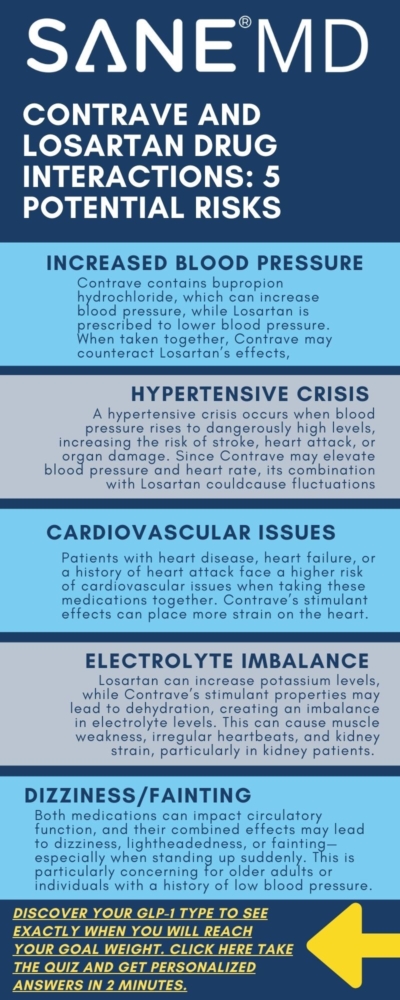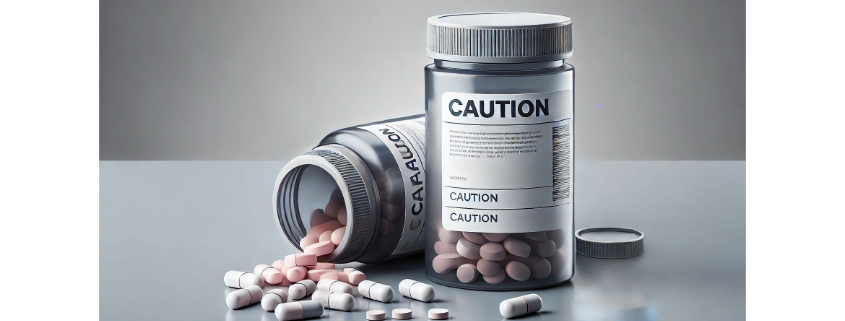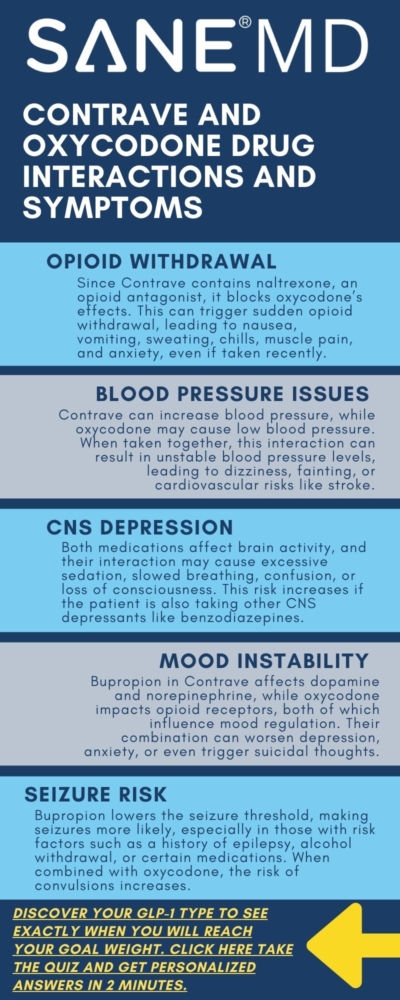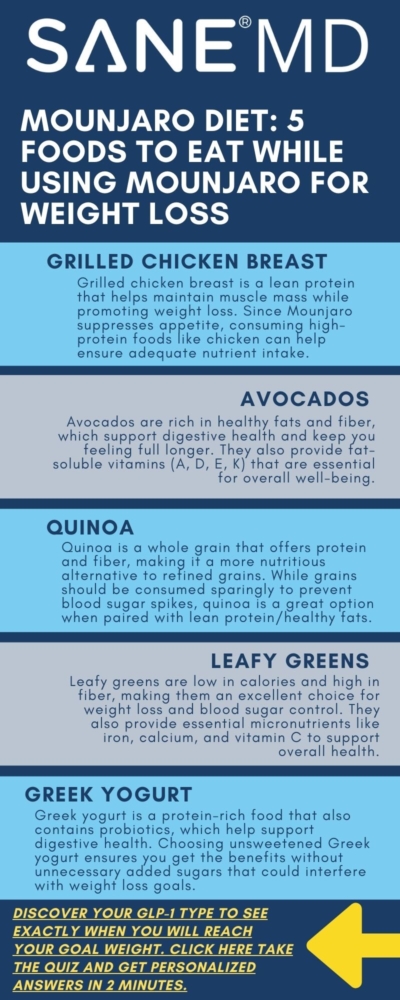Contrave and Losartan Drug Interactions: Safety Warnings

The combination of Contrave and Losartan is a concern for many patients managing both weight loss and blood pressure regulation. While these medications serve distinct purposes, Contrave and Losartan Drug Interactions can lead to unexpected health risks. Understanding Contrave Drug Interactions with Losartan and the potential side effects is crucial for individuals taking them together.
So, if you’re asking, “Is Contrave right for you?,” especially if you’re currently taking Losartan, read on. This article explores the safety concerns, possible complications, and important precautions for using Contrave and Losartan concurrently.
Key Takeaways
- Potential Risks: The combination of Contrave and Losartan may increase the risk of adverse effects, particularly concerning blood pressure regulation.
- Drug Interactions: Patients taking these medications should consult a healthcare provider to assess risks related to other drugs and pre-existing conditions.
- Medical Guidance: Monitoring by a healthcare professional is crucial to minimize potential complications and ensure safe treatment options.
Understanding Contrave and Losartan Drug Interactions
Contrave and Losartan are two widely prescribed medications, but combining them may lead to significant drug interactions. Contrave is a weight loss medication designed to help certain individuals manage their weight, while Losartan is used to treat high blood pressure.
Patients taking Contrave and Losartan should be aware of potential interactions that may increase the risk of adverse effects, including hypertensive crisis and cardiovascular complications.
Contrave and Losartan Drug Interaction Overview
| Medication | Primary Use | Interaction with Contrave | Risks | Precautions |
|---|---|---|---|---|
| Contrave | Weight loss aid | May increase blood pressure | Hypertensive crisis, cardiovascular effects | Monitor blood pressure, consult doctor |
| Losartan | Treats high blood pressure | Effects may be counteracted by Contrave | BP fluctuations, heart complications | Regular monitoring, avoid unsupervised use |
| SSRIs | Treats depression, anxiety disorders | Potential serotonin syndrome, mood instability | CNS stimulation, suicidal thoughts | Doctor consultation before combining |
| Tricyclic Antidepressants | Treats depression, chronic pain | Can intensify Contrave’s effects | Mood instability, cardiovascular risks | Close monitoring, possible dosage adjustments |
| MAOIs | Treats severe depression | Severe interaction risk | Hypertensive crisis, serotonin syndrome | Avoid combining, 14-day washout required |
| Diabetes Medications | Controls blood sugar | May cause low blood sugar | Hypoglycemia, dizziness, confusion | Monitor blood sugar, adjust dosage if needed |
| Beta Blockers & ACE Inhibitors | Treats hypertension, heart disease | May cause cardiovascular instability | Irregular heart rate, BP fluctuations | Regular BP checks, consult a doctor |
What is Contrave?
Contrave is a prescription weight loss drug that combines two active ingredients: bupropion hydrochloride and naltrexone hydrochloride. Bupropion is an antidepressant that affects the central nervous system, while naltrexone is commonly used for opioid dependence.
The combination is designed to help with weight management, particularly in a subset of individuals with obesity-related health conditions.
Active Ingredients in Contrave
- Bupropion hydrochloride – Primarily used for depression and smoking cessation, but also affects appetite regulation.
- Naltrexone hydrochloride – Helps reduce cravings and dependency on addictive substances.
What is Losartan?
Losartan is an antihypertensive drug classified as an angiotensin II receptor blocker (ARB). It is primarily used to treat high blood pressure and heart failure.
Additionally, it reduces the risk of stroke and protects kidney function in individuals with diabetes medications.
Drug Interactions Between Contrave and Losartan
Combining Contrave and Losartan drug interactions may lead to serious health risks. Since Contrave contains bupropion hydrochloride, which can increase blood pressure, and Losartan is used to treat high blood pressure, their simultaneous use could counteract Losartan’s effects, potentially leading to dangerous fluctuations in blood pressure levels.
Both medications influence cardiovascular function in different ways. While Losartan works by relaxing blood vessels to lower blood pressure, Contrave can have stimulatory effects on the central nervous system, which may increase the risk of hypertension and other heart-related concerns.
This interaction requires careful monitoring by a healthcare provider to minimize potential complications.
Potential Risks
Patients taking Contrave and Losartan together should be aware of the following risks:
- Increased blood pressure despite taking an antihypertensive drug, potentially reducing Losartan’s effectiveness.
- Hypertensive crisis, a medical emergency where blood pressure spikes dangerously high, increasing the likelihood of stroke, heart attack, or other cardiovascular complications.
- Adverse effects when mixed with other drugs that affect heart rate, blood pressure, or neurological functions, potentially leading to dizziness, palpitations, or fainting spells.
- Changes in electrolyte balance, as Losartan can increase potassium levels, while Contrave’s stimulant properties may contribute to dehydration and further exacerbate cardiac issues.
- Kidney strain, since both drugs can impact renal function. Losartan is often prescribed to protect kidney health in patients with diabetes, while Contrave may pose additional stress on the kidneys, particularly if dehydration occurs.
It’s important to note that taking other blood pressure medications with Contrave can also present similar risks. For example, Contrave and Lisinopril drug interactions are very common.
Increased Risk of Cardiovascular Effects
Individuals with heart disease, heart failure, or a history of heart attack may face an increased risk of severe cardiovascular effects when using these medications together. Because Contrave contains bupropion hydrochloride, which can increase heart rate and elevate blood pressure, its interaction with Losartan may create instability in blood pressure regulation, making it difficult to maintain safe levels.
Additionally, naltrexone hydrochloride, another active ingredient in Contrave, has been associated with central nervous system effects, which may further complicate cardiovascular health in at-risk individuals.
Symptoms like irregular heartbeats, chest pain, or excessive fatigue should be reported to a healthcare professional immediately.
Beta Blockers and Other Blood Pressure Medications
Patients already taking beta blockers, calcium channel blockers, or ACE inhibitors should exercise caution when combining these with Contrave and Losartan.
Each of these antihypertensive drugs works differently, and adding Contrave into the mix could increase the risk of unpredictable blood pressure fluctuations, making it harder to maintain stable cardiovascular health.
Potential effects of these interactions include:
- Reduced effectiveness of Losartan, leading to higher blood pressure levels.
- Excessive blood pressure lowering, especially when combined with beta blockers or ACE inhibitors, leading to dizziness, fainting, or shock.
- Irregular heart rate, which could be worsened by Contrave’s stimulant properties.
Due to these risks, patients taking Contrave should undergo regular blood pressure monitoring and consult their healthcare provider to ensure that their medications are balanced for safety and effectiveness.
Other Drugs That May Increase the Risk
Beyond Losartan, several other drugs can interact with Contrave, compounding the risk of adverse effects. These interactions can range from cardiovascular complications to neurological issues, including mood disturbances and metabolic instability.

Selective Serotonin Reuptake Inhibitors (SSRIs)
SSRIs, commonly prescribed to treat depression and anxiety disorders, include medications such as fluoxetine (Prozac), sertraline (Zoloft), and escitalopram (Lexapro).
These drugs may interfere with Contrave’s effects, particularly due to the bupropion hydrochloride component, which also affects neurotransmitter activity.
Potential Risks:
- Increased central nervous system stimulation, leading to insomnia, agitation, or anxiety.
- Higher risk of suicidal thoughts, particularly in individuals under the age of 25.
- Potential serotonin syndrome, a life-threatening condition caused by excessive serotonin levels, leading to confusion, high fever, rapid heart rate, and muscle rigidity.
Because of these risks, patients should consult a healthcare professional before combining Contrave and SSRIs, as adjustments to dosages may be necessary.
Tricyclic Antidepressants (TCAs)
Tricyclic antidepressants, such as amitriptyline, nortriptyline, and imipramine, are older antidepressants used to treat depression, chronic pain, and certain neurological conditions.
These medications can interact significantly with Contrave’s active ingredients, particularly bupropion hydrochloride, which affects dopamine and norepinephrine levels.
Potential Risks:
- Increased risk of suicidal thoughts, especially in individuals with a history of mood disorders.
- Cardiovascular effects, including elevated heart rate, blood pressure spikes, or arrhythmias.
- Heightened central nervous system stimulation, potentially leading to restlessness, tremors, and confusion.
Patients using tricyclic antidepressants should be closely monitored when taking Contrave, as the interaction may increase the risk of both mental health conditions and cardiovascular issues.
Monoamine Oxidase Inhibitors (MAOIs)
Monoamine oxidase inhibitors (MAOIs) are a type of antidepressant used to treat severe depression and certain neurological disorders. These include phenelzine (Nardil), tranylcypromine (Parnate), and selegiline (Emsam).
Combining Contrave and MAOIs can lead to serious drug interactions, potentially causing hypertensive crisis or life-threatening central nervous system effects.
Potential Risks:
- Hypertensive crisis, a severe and sudden spike in blood pressure, which can lead to stroke or heart attack.
- Serotonin syndrome, a dangerous buildup of serotonin that can cause hyperthermia, seizures, or coma.
- Severe mood instability, including suicidal thoughts or extreme agitation.
Patients taking Contrave should avoid MAOIs entirely. If switching from an MAOI to Contrave, a 14-day washout period is typically required to prevent severe interactions.
Diabetes Medications
Many individuals prescribed Contrave may also be managing diabetes, leading to potential interactions with diabetes medications such as insulin, metformin, and sulfonylureas (e.g., glipizide, glyburide).
The primary concern is that Contrave may impact blood sugar regulation, potentially causing low blood sugar (hypoglycemia) or reducing the effectiveness of diabetes treatments.
Potential Risks:
- Low blood sugar (hypoglycemia), leading to dizziness, sweating, confusion, and fainting.
- Increased risk of unpredictable blood sugar fluctuations, particularly in patients using insulin.
- Possible metabolic complications, making diabetes management more difficult.
For patients on diabetes medications, close blood sugar monitoring is necessary while taking Contrave.
Healthcare providers may need to adjust medication dosages to prevent dangerous drops in blood sugar.
Other Medications to Watch Out For
In addition to the major drug classes listed above, several other medications may interact with Contrave, requiring careful consideration:
- Beta blockers – Used to treat high blood pressure and heart conditions; may interfere with Contrave’s stimulant effects, leading to cardiovascular instability.
- Calcium channel blockers – Can affect heart rate and blood pressure, potentially increasing the risk of adverse effects.
- ACE inhibitors – Another class of antihypertensive drugs that may interact with Contrave’s impact on blood pressure regulation.
- Opioid pain medications – Since naltrexone hydrochloride in Contrave is used to treat opioid dependence, it can block the effects of opioid-based painkillers, leading to ineffective pain management and potential withdrawal symptoms. See our guide on Contrave and Oxycodone drug interactions for more information. Contrave and Tramadol can also lead to dangerous drug interactions.
- Over-the-counter (OTC) medications and herbal supplements – Drugs such as cold medicine, allergy medications, and herbal supplements (including red yeast rice) can interfere with Contrave, increasing the risk of adverse effects.
Contrave and Gabapentin Drug Interactions can also occur, increasing the risk of seizures and mood disturbances.
Because of these complex drug interactions, individuals taking Contrave should inform their healthcare provider about all other medications, nutritional supplements, and over-the-counter drugs they are using.
Regular monitoring and adjustments may be needed to minimize risks and ensure safe treatment outcomes.
Over-the-Counter and Herbal Supplement Interactions
Many over-the-counter drugs and herbal supplements, including red yeast rice, may increase the risk of unpredictable side effects when taken alongside Contrave and Losartan.
Patients should always consult a healthcare professional before taking certain medications or supplements while using these drugs.
Clinical Studies on Contrave and Losartan Interactions
A clinical study involving healthy volunteers investigated potential drug interactions between Contrave and antihypertensive drugs.
Findings indicated that combining them may increase the risk of blood pressure spikes, stomach pain, and skin rash.
Clinical Trials and Findings
- Clinical trials have shown that patients taking Contrave may experience fluctuations in blood pressure levels.
- Certain drug interactions have led to concerns about worsening cardiovascular health conditions.
- Studies recommend monitoring patients for any signs of adverse effects while using these medications together.
Risks for Individuals with Pre-existing Medical Conditions
Patients with the following medical conditions should use caution when taking Contrave and Losartan:
- Heart disease or a history of heart attack
- High cholesterol or other cardiovascular issues
- Mental health conditions, particularly those requiring certain antidepressants
- Liver problems or a history of medication-induced complications
- Individuals treating ADHD with stimulant-based drugs
Safety Measures and Medical Advice
Consult a Healthcare Professional
Anyone taking Contrave alongside Losartan should work closely with a healthcare provider to monitor their blood pressure and overall health.
A medication guide should be followed to reduce the risk of negative interactions.
Signs That Require Medical Attention
Seek medical attention immediately if experiencing:
- Hypertensive crisis (sudden, severe rise in blood pressure)
- Skin rash, stomach pain, or other allergic reactions
- Signs of low blood sugar
- Suicidal thoughts or drastic mood changes
Frequently Asked Questions (FAQ)
Navigating potential drug interactions between Contrave and Losartan can be complex, especially for individuals managing weight loss and high blood pressure simultaneously. Understanding how these medications interact, their potential risks, and which drugs should be avoided is crucial for ensuring safe treatment.
In this FAQ section, we address common concerns regarding the combination of Contrave and Losartan, as well as other medications that may pose a risk when taken with Contrave. Whether you’re wondering about cardiovascular effects, blood pressure management, or general safety, this guide provides clear answers to help you make informed decisions. Always consult a healthcare provider before making any changes to your medication regimen.
1. Can you take Losartan and Contrave together?
Taking Losartan and Contrave together is not generally recommended without medical supervision. Since Contrave contains bupropion hydrochloride, which can increase blood pressure, and Losartan is prescribed to treat high blood pressure, their combined use may counteract Losartan’s effects or cause hypertensive crisis.
Patients with existing heart disease, high blood pressure, or other cardiovascular conditions should consult their healthcare provider before using these medications together.
2. Can you take Contrave with blood pressure medicine?
Contrave should be used cautiously with blood pressure medicine. Certain antihypertensive drugs, such as beta blockers, ACE inhibitors, and calcium channel blockers, may interact with Contrave, leading to unpredictable blood pressure changes.
Because Contrave can increase blood pressure, individuals taking medications to treat high blood pressure should have their condition closely monitored to avoid cardiovascular effects like an irregular heart rate or hypertensive crisis.
3. What medications should not be taken with Contrave?
Several medications may interact negatively with Contrave, increasing the risk of adverse effects.
These include:
- Monoamine oxidase inhibitors (MAOIs) – Can cause hypertensive crisis and serotonin syndrome.
- Tricyclic antidepressants (TCAs) – May increase suicidal thoughts and cardiovascular issues.
- Selective serotonin reuptake inhibitors (SSRIs) – Can lead to serotonin syndrome and mood instability.
- Diabetes medications – May cause low blood sugar.
- Opioid pain medications – Naltrexone hydrochloride in Contrave can block opioid effects, leading to withdrawal symptoms.
- Over-the-counter medications and herbal supplements – Some medications, such as cold medicine, allergy medications, and red yeast rice, may interfere with Contrave’s effects.
- Beta blockers and calcium channel blockers – May contribute to cardiovascular instability when used with Contrave.
4. Does buPROPion interact with Losartan?
Yes, bupropion hydrochloride, one of the active ingredients in Contrave, may interact with Losartan. Bupropion can increase blood pressure, which could reduce the effectiveness of Losartan in managing high blood pressure.
Additionally, both drugs may have effects on heart rate and kidney function, making their combination potentially problematic for individuals with cardiovascular or renal conditions.
5. Can you take Losartan and Contrave together?
The combination of Losartan and Contrave should only be taken under the guidance of a healthcare professional. Since Contrave may increase blood pressure, while Losartan is intended to lower blood pressure, their simultaneous use may require careful monitoring to prevent hypertensive crisis or cardiovascular side effects.
Patients should regularly check their blood pressure and report any unusual symptoms to their doctor.
Conclusion
Contrave and Losartan drug interactions can pose significant risks to individuals with high blood pressure or cardiovascular concerns. Taking Contrave should always be done under the supervision of a healthcare provider to minimize increased risk and ensure safe use.
Regular monitoring, cautious use of other medications, and lifestyle adjustments play crucial roles in maintaining health while on these drugs.

Contrave and Oxycodone Drug Interactions: What to Know

When considering the use of multiple medications, understanding potential drug interactions is crucial to ensure both safety and effectiveness. Contrave (a combination of naltrexone bupropion) is a prescription weight loss medication primarily used for chronic weight management for compatible individuals, while oxycodone is an opioid analgesic commonly prescribed to treat pain ranging from moderate to severe pain.
Due to their differing mechanisms of action, Contrave and oxycodone drug interactions present significant risks. These include increased chances of opioid withdrawal, altered blood pressure levels, and central nervous system depression. Patients taking these medications together need to be closely monitored for potential adverse reactions and health conditions that may require a dose adjustment.
This article explores Contrave drug interactions with oxycodone, the increased risk of certain side effects, and what patients should discuss with their healthcare providers before combining these medications.
Key Takeaways
- Risk of Opioid Withdrawal: Taking Contrave while using oxycodone may trigger opioid withdrawal symptoms, including nausea, vomiting, and increased sensitivity to pain.
- Effects on Blood Pressure: Contrave treatment may cause high blood pressure or low blood pressure, which can be exacerbated when taken with opioids.
- Mental Health Considerations: Both drugs can influence mental health, increasing the potential for suicidal thoughts, mental health conditions, or severe mood changes.
How Contrave Works
Contrave contains two active ingredients:
- Naltrexone – An opioid antagonist used to treat alcohol and opioid withdrawal disorders.
- Bupropion – An atypical antidepressant that helps treat depression, but is also used for chronic weight management for certain individuals by reducing food cravings.
Because naltrexone bupropion affects opioid receptors, taking Contrave while using opioid analgesics like oxycodone can lead to significant drug interactions and serious health risks.
How Oxycodone Works
Oxycodone is a central nervous system (CNS) depressant and opioid medication that helps treat pain by altering how the brain perceives discomfort. However, it can cause physical dependence, meaning sudden discontinuation can trigger opioid withdrawal symptoms such as:
- Severe nausea and vomiting
- Muscle pain and restlessness
- Increased heart rate and anxiety
Combining oxycodone with Contrave can create dangerous Contrave interactions, leading to serious withdrawal effects and requiring a dosage adjustment under medical supervision.
Why Contrave and Oxycodone May Be Incompatible
When taking multiple medications, it’s essential to consider how they interact within the body. In the case of Contrave and oxycodone, their combined use presents significant risks that can lead to severe side effects, particularly for individuals who rely on opioids for chronic pain management.
The naltrexone bupropion combination in Contrave treatment works by altering brain chemistry to reduce appetite and cravings. However, oxycodone is a central nervous system (CNS) depressant that interacts with opioid receptors to treat pain effectively.
Because naltrexone in Contrave treatment is an opioid antagonist, it blocks the effects of opioid medications like oxycodone, potentially leading to opioid withdrawal symptoms. Additionally, both medications impact blood pressure, and their combined effects on mental health conditions increase the risk of suicidal thoughts and mood instability. These concerns make it crucial for healthcare providers to assess the risks before prescribing both medications together.
Below are the key reasons why taking Contrave and oxycodone together is generally not recommended.
1. Risk of Opioid Withdrawal Symptoms
One of the most severe risks of combining Contrave and oxycodone is the potential for opioid withdrawal symptoms. This occurs because Contrave treatment contains naltrexone, which directly blocks opioid receptors in the brain.
For individuals dependent on opioid analgesics, such as oxycodone, this can cause sudden and severe withdrawal symptoms, even if they have only been using opioids for a short period.
Common opioid withdrawal symptoms include:
- Severe nausea and vomiting
- Intense muscle aches and cramping
- Increased heart rate and blood pressure fluctuations
- Anxiety, restlessness, and insomnia
- Sweating and chills
Withdrawal symptoms can be extremely distressing and, in some cases, require medical emergency intervention. Patients taking oxycodone for chronic pain should not abruptly stop opioid use before starting Contrave treatment, as it could trigger opioid withdrawal and lead to unnecessary discomfort and health risks.
If taking Contrave is necessary for chronic weight management, healthcare providers must carefully plan the transition, often requiring a gradual opioid taper before initiating Contrave.

2. Blood Pressure Concerns
Another serious issue with Contrave and oxycodone drug interactions is their conflicting effects on blood pressure. Contrave treatment has been associated with increased blood pressure, whereas oxycodone may lead to low blood pressure. This dual effect creates an unstable environment in the body, making it difficult to regulate blood circulation properly.
For patients with high blood pressure or severely high blood pressure, taking Contrave can increase the risk of cardiovascular complications, such as:
- Hypertensive reactions
- Increased heart rate (tachycardia)
- Risk of seizures due to excessive blood pressure spikes
- Increased likelihood of stroke or heart attack
On the other hand, oxycodone may cause low blood pressure, which can result in dizziness, fainting, and weakness. If a person taking Contrave experiences these blood pressure fluctuations, a dose adjustment may be necessary, or an alternative weight loss approach may need to be considered.
Healthcare providers should:
- Regularly monitor blood pressure in patients taking Contrave treatment
- Consider dosage adjustment or alternative weight loss therapies for those at risk of hypertensive reactions
- Assess for potential contraindications in individuals with cardiovascular health conditions
If a patient taking Contrave notices symptoms such as severe headaches, chest pain, or blurred vision, they should tell their doctor immediately to avoid a medical emergency.
3. Mental Health Risks and Suicidal Thoughts
Naltrexone bupropion in Contrave treatment and oxycodone both have significant effects on mental health, which can be particularly concerning for individuals with mental health conditions such as:
- Bipolar disorder
- Eating disorders
- History of suicidal thoughts or self-harm
The boxed warning alerts doctors to the increased risk of suicidal thoughts, mood swings, and mental health changes when using naltrexone bupropion. Adding oxycodone into the mix can further alter mental health, as opioids have been known to cause depression, mood instability, and even opioid-induced psychiatric disorders.
Potential mental health effects of combining Contrave and oxycodone:
- Increased risk of anxiety and agitation
- Emotional instability and unusual tiredness
- Increased sensitivity to pain and distress
- Suicidal thoughts or self-harming behaviors
For patients with pre-existing mental health conditions, taking Contrave alongside oxycodone can lead to dangerous psychiatric effects, requiring medical emergency intervention. Anyone experiencing mental health changes while using these medications should contact their healthcare provider immediately or call their local emergency number for support.
Potential Side Effects of Combining Contrave and Oxycodone
Patients who combine Contrave and oxycodone may experience:
- Dizziness, confusion, and unusual tiredness
- Gastrointestinal issues, including nausea and vomiting
- Severe headaches and skin rash
- Fluctuations in blood pressure (either too high or too low)
- CNS depression, especially when taken with other CNS depressants
If any of these symptoms occur, tell your doctor immediately or call your local emergency number for urgent medical care.
Potential Side Effects of Combining Contrave and Oxycodone
| Potential Side Effect | Description |
|---|---|
| Dizziness, Confusion, & Fatigue | CNS depression can cause extreme drowsiness and confusion. |
| Gastrointestinal Issues | Nausea, vomiting, and stomach discomfort may occur due to opioid withdrawal or drug interactions. |
| Severe Headaches & Skin Rash | Possible allergic reactions or neurological effects from medication interaction. |
| Blood Pressure Fluctuations | May cause dangerously high or low blood pressure, leading to cardiovascular risks. |
| CNS Depression | Combining these drugs with other CNS depressants increases the risk of sedation and respiratory depression. |
Warnings and Precautions
When considering the use of Contrave treatment, especially alongside oxycodone or other medications, it is crucial to understand the potential risks. The combination of these drugs can lead to serious warning signs, including an increased risk of severe side effects such as opioid withdrawal symptoms, blood pressure fluctuations, and mental health changes.
Before taking Contrave, patients must inform their healthcare provider about their health history, including medical conditions, other drugs they are using, and whether they have ever taken opioid analgesics for chronic pain. The presence of certain drug interactions and over-the-counter drugs can lead to adverse reactions, making it necessary to proceed with caution.
The following warnings highlight the most critical Contrave interactions and health conditions that require special consideration.
1. Certain Drug Interactions and Over-the-Counter Drugs
One of the most significant concerns with taking Contrave is how it interacts with certain medications and over-the-counter drugs. Some of these drug interactions can lead to severe pain management issues, increased blood pressure, or even an increased risk of seizures.
Common drug interactions include:
- CNS depressants like benzodiazepines: Medications such as Xanax (alprazolam), Valium (diazepam), and Ativan (lorazepam) are central nervous system depressants that can cause sedation, drowsiness, and impaired motor function. Since Contrave treatment contains bupropion, which has stimulant-like effects, combining it with CNS depressants may increase the risk of mental health changes and dangerous side effects such as respiratory depression or severe drowsiness.
- Other medications that affect dopamine levels: Bupropion in naltrexone bupropion influences dopamine activity in the brain. If combined with other drugs that regulate dopamine—such as antidepressants, stimulant medications for ADHD, or medicines used to treat depression—the risk of mental health changes and seizures increases significantly.
- Over-the-counter pain relievers that can impact opioid metabolism: Some over-the-counter drugs, particularly nonsteroidal anti-inflammatory drugs (NSAIDs) like ibuprofen (Advil) and naproxen (Aleve), can affect how the liver processes medications. These over-the-counter drugs may interfere with oxycodone metabolism, leading to either reduced pain relief or increased systemic exposure to opioids, which may worsen side effects.
- Blood Pressure Medications, Including Losartan: Contrave and Losartan drug interactions can lead to unpredictable blood pressure fluctuations, making it difficult to manage hypertension effectively.
To minimize Contrave side effects and risks, patients should always tell their doctor about any over-the-counter or prescription medications they take before starting Contrave treatment. Consulting a healthcare professional ensures that potential drug interactions are carefully managed, reducing the likelihood of adverse reactions.
2. Contrave Interacts with Medical Conditions
Certain health conditions can make taking Contrave particularly risky, especially when combined with oxycodone or other opioid analgesics.
Individuals with any of the following medical conditions should not take Contrave unless under strict medical supervision:
Seizure Disorder
Contrave treatment carries a serious warning for individuals with a seizure disorder, as bupropion lowers the seizure threshold, making seizures more likely. Taking Contrave in combination with oxycodone, which can also affect central nervous system activity, increases the risk of seizures even further.
Those with a history of seizures should avoid naltrexone bupropion, as it may lead to life-threatening convulsions. If patients have any symptoms of neurological instability—such as unusual tiredness, confusion, or muscle twitching—they should tell their doctor immediately.
Chronic Pain Requiring Opioid Analgesics
Patients who rely on opioid analgesics for chronic pain should not take Contrave without careful monitoring. Since naltrexone in Contrave treatment blocks opioid effects, it can trigger opioid withdrawal symptoms in individuals who have physical dependence on oxycodone or other opioid analgesics.
Common opioid withdrawal symptoms include:
- Severe nausea and vomiting
- Sweating and chills
- Increased heart rate and blood pressure fluctuations
- Restlessness and insomnia
If a patient requires opioid medications to treat pain, a healthcare provider may recommend alternative weight loss drugs that do not contain naltrexone. Tell your doctor if you are using opioids before starting Contrave treatment, as stopping oxycodone suddenly could result in a medical emergency.
Alcohol Use Disorder
Because naltrexone bupropion is used to treat alcohol dependence, taking Contrave may not be suitable for individuals with alcohol use disorder who are still actively drinking alcohol.
Patients with a history of alcohol dependence should avoid suddenly stopping drinking alcohol while on Contrave treatment, as it can lead to severe withdrawal symptoms, including:
- Seizures (particularly in those with a history of binge drinking)
- Severely high blood pressure spikes
- Increased risk of seizures due to alcohol withdrawal combined with bupropion
- Agitation, hallucinations, or mental health changes
Tell your doctor if you have a history of alcohol use disorder before starting Contrave treatment. If you experience dark urine, confusion, or difficulty breathing, call a local emergency number immediately.
When to Seek Immediate Medical Attention
Call a local emergency number if you experience:
- Severe allergic reaction (swelling, hives, difficulty breathing)
- Dark urine, which may indicate liver damage
- Uncontrollable high or low blood pressure
- Signs of a brain tumor, including extreme dizziness and vision changes
These symptoms require immediate care to prevent serious warning effects from Contrave interactions.
Alternatives to Contrave for Patients Taking Oxycodone
If Contrave is not a safe option due to drug interactions, alternative weight loss drugs include:
- GLP-1 receptor agonists (like Ozempic or Wegovy). It’s important to note that there can be certain interactions between Contrave and GLP-1 medications. Please see our guide about potential drug interactions that may occur when taking Contrave and Ozempic together.
- Prescription appetite suppressants
- Reduced calorie diet combined with lifestyle changes
Discuss alternative options with a healthcare provider to determine the safest chronic weight management approach.
FAQ: Contrave and Oxycodone Drug Interactions
Navigating potential drug interactions is crucial for individuals taking Contrave, especially those who also use opioid medications like oxycodone. Understanding how Contrave interacts with opioids and other medications can help prevent serious health risks, including withdrawal symptoms, blood pressure fluctuations, and central nervous system complications.
Below are answers to common questions about taking Contrave with opioids and other medications to help guide safe and informed decisions.
1. Can you take Contrave with opioids?
You should not take Contrave with opioids unless under strict medical supervision. Contrave contains naltrexone, which blocks opioid receptors in the brain, making opioids like oxycodone, hydrocodone, and morphine ineffective for pain relief.
Additionally, if an individual is dependent on opioids, taking Contrave treatment can trigger sudden opioid withdrawal symptoms, which may be severe and require medical intervention.
Before starting Contrave treatment, it is important to inform your doctor about any current or recent opioid use. If pain management is necessary, a healthcare provider may recommend alternative non-opioid pain relief options to avoid dangerous Contrave interactions.
2. What pain medicine can I take with Contrave?
If you need pain relief while taking Contrave, it is generally safer to use non-opioid pain relievers such as acetaminophen (Tylenol) or nonsteroidal anti-inflammatory drugs (NSAIDs) like ibuprofen (Advil, Motrin) or naproxen (Aleve). These over-the-counter options do not interfere with naltrexone bupropion and can help manage mild to moderate pain without causing dangerous drug interactions.
However, some NSAIDs may increase blood pressure, so individuals with high blood pressure should consult their healthcare provider before using them regularly. In cases of severe pain, alternative prescription non-opioid pain medications may be considered under medical supervision.
Tell your doctor if you require pain management so they can recommend the safest option while taking Contrave treatment.
3. Can I take oxycodone and bupropion together?
Taking oxycodone and bupropion together is not recommended without medical oversight due to the increased risk of drug interactions and potential central nervous system (CNS) complications. Bupropion, one of the active ingredients in Contrave, lowers the seizure threshold, while oxycodone, an opioid analgesic, can cause sedation and respiratory depression. When combined, these effects may increase the risk of seizures, excessive drowsiness, or breathing difficulties.
Additionally, naltrexone bupropion in Contrave treatment blocks opioid receptors, making oxycodone ineffective for pain relief and potentially triggering opioid withdrawal symptoms.
If you have been prescribed both medications, it is essential to tell your doctor to discuss alternative treatment options that do not pose significant risks.
4. What medications should I avoid with Contrave?
Certain medications should be avoided while taking Contrave due to the increased risk of drug interactions and serious health complications.
These include:
- Opioid medications, such as oxycodone, hydrocodone, fentanyl, or morphine, because Contrave blocks opioid receptors, leading to opioid withdrawal symptoms.
- CNS depressants, including benzodiazepines (Xanax, Valium, Ativan) and muscle relaxants, which can increase sedation and respiratory depression when taken with bupropion.
- Seizure medications or drugs that lower the seizure threshold, such as tramadol, antipsychotics, and certain antidepressants, due to the risk of seizures.
- Monoamine oxidase inhibitors (MAOIs), a class of antidepressants, which can cause serious hypertensive reactions when combined with Contrave treatment.
Stimulant-based medications like Phentermine can also interact with Contrave. Learn more about the risks in our guide on Contrave and Phentermine together drug interactions.
Before starting Contrave treatment, always tell your doctor about any other medications you are taking, including over-the-counter drugs, herbal supplements, and vitamins, to avoid harmful Contrave interactions.
5. What happens if you take opioids with Contrave?
Taking opioids with Contrave can lead to serious and potentially dangerous consequences. Because Contrave contains naltrexone, it blocks opioid receptors, making opioids ineffective for pain relief.
This can cause opioid-dependent individuals to experience sudden and severe withdrawal symptoms, including:
- Nausea, vomiting, and diarrhea
- Severe anxiety and restlessness
- Sweating, chills, and rapid heartbeat
- Muscle pain, body aches, and fatigue
Additionally, if someone tries to override Contrave’s opioid-blocking effects by taking higher doses of opioids, they may experience life-threatening respiratory depression or overdose. Patients using opioid analgesics should stop taking them at least 7–10 days before starting Contrave treatment to avoid these complications.
Always consult a licensed healthcare provider before stopping or switching any opioid medications.
Final Thoughts
Understanding Contrave and oxycodone drug interactions is crucial for individuals managing chronic pain, weight loss, or other health conditions requiring medication. Since taking Contrave may increase the risk of opioid withdrawal, mental health issues, and high blood pressure, it is essential to consult a doctor before combining these medications.
If you experience mental health changes, suicidal thoughts, or severe allergic reactions, seek immediate medical assistance by calling your local emergency number. By staying informed and working with a healthcare provider, patients can make the best decisions for their overall health.

Mounjaro Diet: What to Eat and Avoid for Best Results

The Mounjaro diet is designed to complement the effects of Mounjaro (tripeptide), a medication originally developed for type 2 diabetes that has gained popularity as a weight loss aid. While taking Mounjaro, it is essential to eat foods that support its benefits and avoid those that may hinder progress. Indeed, enjoying these healthy foods could be the key to your weight loss success.
A healthy diet while on Mounjaro should focus on lean protein, healthy fats, whole grains, and non-starchy vegetables. It should also limit processed foods, sugary drinks, and unhealthy fats. This guide explores what to eat on Mounjaro for the best results and which foods to avoid.
How Mounjaro Affects Diet and Appetite
Mounjaro targets blood sugar levels and appetite regulation through GLP-1 and GIP receptor activation. This dual mechanism plays a crucial role in managing body weight by reducing hunger and calorie intake, slowing digestion, and promoting feelings of fullness for compatible individuals. Check out our article titled “What is Mounjaro” to learn more about this drug.
Appetite Suppression and Satiety
Mounjaro affects hunger hormones, making it easier to consume fewer calories without feeling deprived. By slowing gastric emptying, food remains in the stomach longer, enhancing digestive health and reducing the likelihood of overeating.
This makes it important to eat smaller meals while ensuring adequate nutrient-rich foods are consumed to prevent deficiencies.
Blood Sugar Regulation
Mounjaro helps control blood sugar levels by improving insulin sensitivity and reducing glucose production in the liver. For individuals considering bariatric surgery, Mounjaro may be prescribed before or after the procedure to assist with weight management. Learn more about Mounjaro and weight loss surgery.
Maintaining stable blood sugar levels helps prevent energy crashes and reduces cravings for sugary and processed foods, which can hinder weight loss goals.
Impact on Digestion and Nutrient Absorption
Due to its effects on digestion, some individuals may experience mild digestive health changes, such as nausea, bloating, or slower bowel movements. Incorporating fiber-rich foods, lean protein, and healthy fats can ease these symptoms while supporting metabolism and gut health.
Additionally, drinking plenty of water is essential to counteract potential dehydration and promote smooth digestion.
The Importance of a Balanced Diet
Since Mounjaro reduces appetite, ensuring a balanced diet with whole grains, lean protein, and non-starchy vegetables is crucial to maintaining muscle mass and overall well-being. Skipping meals or consuming too few calories can lead to nutrient deficiencies, fatigue, and reduced effectiveness of the medication.
By focusing on a diet rich in nutrient-dense foods, compatible patients can optimize the benefits of Mounjaro and sustain long-term weight loss journey success.
Mounjaro Diet: What to Eat and Avoid
| Food Category | Recommended | Foods to Avoid |
|---|---|---|
| Lean Protein | Grilled chicken breast, turkey, cottage cheese, Greek yogurt, eggs, tofu, tempeh, beans, lentils, salmon, tuna, cod | – |
| Healthy Fats | Olive oil, avocado oil, almonds, walnuts, chia seeds, fatty fish (salmon, mackerel, sardines), dairy alternatives (unsweetened almond or coconut milk) | – |
| Whole Grains | Brown rice, whole wheat pasta, quinoa, oats, whole grain bread (consume sparingly to avoid blood sugar spikes) | – |
| Non-Starchy Vegetables | Broccoli, cauliflower, Brussels sprouts, spinach, kale, arugula, zucchini, bell peppers, cucumbers, carrots, radishes, asparagus | – |
| Fruits and Vegetables | Fresh fruit (berries, apples, pears), citrus fruits (oranges, grapefruit, lemons), fermented foods (kimchi, sauerkraut, yogurt) | – |
| Fiber-Rich Foods | Lentils, beans, chia seeds, flaxseeds, leafy greens, whole grains like wheat pasta and oats (in moderation) | – |
| Hydration | Water, herbal teas, unsweetened electrolyte drinks | – |
| Processed Foods | – | Packaged snacks (chips, cookies, candy bars), fast food, frozen meals high in sodium |
| Sugary Foods and Drinks | – | Fruit juices with added sugars, carbonated drinks, energy drinks high in sugar |
| Refined Carbohydrates | – | White bread, refined grains, pastries, cakes |
| Fried Foods & Unhealthy Fats | – | Fried chicken, French fries, trans fats from processed snacks, excessive butter, margarine, and cream |
| Alcohol & Sugary Cocktails | – | Beer, wine, spirits, sugary cocktails |
| Spicy Foods | – | Monitor tolerance and adjust if causing digestive discomfort |
Best Foods to Eat on the Mounjaro Diet
Maintaining a healthy diet while taking Mounjaro for weight loss involves focusing on whole, unprocessed foods that help stabilize blood sugar levels, provide essential nutrients, and support digestion. Choosing the right foods can maximize weight loss while ensuring overall well-being.
Lean Protein
A Mounjaro diet plan should prioritize lean protein, which helps build muscle mass and supports weight loss.
Protein-rich options include:
- Skinless poultry (grilled chicken breast, turkey)
- Cottage cheese and Greek yogurt
- Eggs
- Tofu and tempeh
- Beans and lentils
- Fish and seafood (salmon, tuna, cod)
Consuming protein-rich foods with every meal ensures sustained energy and helps prevent muscle loss while losing weight.
Healthy Fats
Incorporating more healthy fats in your diet provides fat-soluble vitamins and supports digestive health.
Best sources include:
- Olive oil and avocado oil
- Nuts and seeds (almonds, walnuts, chia seeds)
- Fatty fish (salmon, mackerel, sardines)
- Dairy alternatives like unsweetened almond or coconut milk
These healthy fats contribute to satiety, making it easier to stick to a balanced diet while on Mounjaro.
Whole Grains
Switching from refined grains to whole grains improves blood sugar control and provides long-lasting energy. However, grains—even whole grains—can raise blood sugar levels quickly.
It is best to consume them sparingly to avoid unnecessary blood sugar spikes.
Choose:
- Brown rice
- Whole wheat pasta
- Quinoa
- Oats
- Whole grain bread
Pairing whole grains with lean protein or healthy fats can help moderate their impact on blood sugar.
Non-Starchy Vegetables
Eating non-starchy vegetables supports digestive health and prevents blood sugar spikes. The best choices include:
- Broccoli, cauliflower, Brussels sprouts
- Spinach, kale, arugula
- Zucchini, bell peppers, cucumbers
- Carrots, radishes, asparagus
These vegetables are fiber-rich foods, high in vitamins and minerals while being low in calories, making them ideal for weight loss.
Fruits and Vegetables
Fruits are an essential part of a balanced diet, but some have a higher glycemic index and may affect blood sugar levels.
Opt for:
- Fresh fruit like berries, apples, pears
- Citrus fruits (oranges, grapefruit, lemons)
- Fermented foods (kimchi, sauerkraut, yogurt) to support digestive health
Fiber-Rich Foods
Fiber-rich foods promote satiety and weight loss by improving digestion.
Include:
- Lentils and beans
- Chia seeds and flaxseeds
- Leafy greens
- Whole grains like wheat pasta and oats (in moderation)
Hydration: Drink Plenty of Water
Proper hydration is crucial while on Mounjaro.
Drink plenty of:
- Water
- Herbal teas
- Electrolyte drinks (unsweetened)
Staying hydrated aids digestion, supports blood sugar control, and prevents dehydration-related fatigue.
Foods to Avoid on the Mounjaro Diet
Maintaining a healthy lifestyle while using Mounjaro requires avoiding certain foods that may hinder weight loss, disrupt blood sugar levels, and contribute to digestive health issues.
These foods can counteract the benefits of the medication and should be limited or eliminated from the diet.

Processed Foods
Ultra-processed foods often contain high levels of trans fats, sodium, and added sugars, which contribute to weight gain and poor digestive health.
These foods should be avoided:
- Packaged snacks (chips, cookies, candy bars)
- Fast food (burgers, fries, fried chicken)
- Frozen meals high in sodium
Sugary Foods and Drinks
Sugary foods and sugary drinks cause blood sugar spikes, leading to cravings and making losing weight more difficult.
Avoid:
- Fruit juices with added sugars
- Carbonated drinks like soda
- Energy drinks high in sugar
Refined Carbohydrates
Refined carbohydrates provide little nutritional value and can lead to rapid blood sugar spikes.
Limit:
- White bread
- Refined grains
- Pastries and cakes
Fried Foods and Unhealthy Fats
Fried foods and fatty and saturated foods can slow digestion, cause inflammation, and contribute to poor health outcomes.
Avoid:
- Fried chicken, French fries
- Trans fats found in processed snacks
- Saturated fat from excessive butter, margarine, and cream
Alcohol and Sugary Cocktails
Alcohol disrupts blood sugar levels and provides empty calories that do not support weight loss goals. Limit:
- Beer, wine, and spirits
- Sugary cocktails
Spicy Foods
Some individuals experience digestive discomfort with spicy foods while on Mounjaro. If symptoms arise, adjust intake accordingly.
Meal Timing and Portion Control on the Mounjaro Diet
Managing meal timing and portion control is crucial when taking Mounjaro, as the medication affects appetite and digestion.
Establishing structured eating habits can enhance weight loss, improve digestive health, and prevent discomfort related to slowed gastric emptying.
Eat Smaller Meals
Since Mounjaro slows digestion, consuming smaller meals throughout the day helps prevent bloating, discomfort, and excessive fullness.
Instead of eating large portions, aim for balanced meals that include:
- Lean protein (chicken, fish, tofu) to maintain muscle mass
- Healthy fats (avocado, olive oil, nuts) to increase satiety
- Fiber-rich foods (vegetables, legumes, whole grains) to aid digestion
Spacing out nutrient-dense meals allows the body to absorb nutrients effectively while minimizing the risk of nausea or digestive distress.
Stop Eating When Full
Mounjaro affects hunger hormones, making it easier to miss fullness cues. It is essential to recognize when to stop eating before reaching discomfort.
Some strategies to prevent overeating include:
- Eating slowly and mindfully to assess satiety
- Avoiding distractions like TV or smartphones while eating
- Using smaller plates to control portion sizes
- Drinking water before meals to support digestion
Over time, these habits help regulate food intake, ensuring that individuals consume adequate nutrients without excessive calories.
By following structured meal timing and portion control practices, certain individuals taking Mounjaro can experience sustained weight loss, improved digestion, and better blood sugar regulation.
Common Diet Challenges and How to Overcome Them
Adapting to dietary changes while taking Mounjaro can come with challenges. Many individuals experience shifts in appetite, digestion, and nutrient absorption, which can impact their overall health if not properly managed.
By recognizing these common issues and applying practical solutions, individuals can maximize their weight loss journey while maintaining a balanced diet.
Managing Appetite Suppression
Mounjaro’s appetite-suppressing effects can lead to significantly reduced food intake, making it difficult to meet daily nutritional needs. While this is beneficial for losing weight, inadequate calorie and protein intake can result in muscle loss, fatigue, and nutrient deficiencies.
To ensure proper nourishment, individuals should focus on protein-rich foods that are easy to consume, even in smaller portions.
Options include:
- Cottage cheese and Greek yogurt for a high-protein, easy-to-digest snack
- Grilled chicken salad, which provides both lean protein and fiber
- Eggs and tofu, versatile sources of protein that can be incorporated into meals
- Smoothies with protein powder, nut butter, and fresh fruit for a nutrient-dense, easy-to-consume option
Eating smaller, frequent meals rather than large portions can also help maintain muscle mass and sustain energy levels.
Handling Digestive Side Effects
Due to its impact on digestion, some individuals experience nausea, bloating, or constipation while adjusting to Mounjaro. This can make it difficult to tolerate certain foods, leading to reduced food intake and discomfort.
To ease digestive distress, individuals should focus on nutrient-rich foods that are gentle on the stomach and promote digestive health:
- Whole wheat pasta and steamed vegetables provide fiber without excessive bloating
- Fermented foods (yogurt, kimchi, sauerkraut) help support digestive health by introducing beneficial probiotics
- Ginger tea or peppermint tea can soothe nausea and improve digestion
- Hydration is key—drink plenty of water to prevent dehydration and keep digestion smooth
Avoiding fried foods, carbonated drinks, and excessive dairy can also reduce bloating and discomfort.
Preventing Nutritional Deficiencies
With appetite suppression and digestive changes, ensuring a well-rounded, nutrient-rich diet is essential to prevent deficiencies. Many individuals may unintentionally consume fewer essential vitamins and minerals, affecting their overall health.
To maintain optimal nutrition, individuals should incorporate foods high in:
- Fat-soluble vitamins (A, D, E, K), found in olive oil, nuts, and leafy greens
- Whole grains such as quinoa and brown rice to provide sustained energy and fiber
- Fresh fruit like berries and citrus, which are packed with antioxidants and vitamin C
- Lean protein and dairy alternatives to maintain muscle mass and bone health
In some cases, a multivitamin supplement may be beneficial, especially for those struggling to meet daily dietary requirements.
Consulting a healthcare provider can help tailor supplementation needs based on individual health goals.
By addressing these common diet challenges proactively, individuals taking Mounjaro can enhance their weight loss journey while maintaining energy, proper digestion, and overall well-being.
FAQ: Frequently Asked Questions About the Mounjaro Diet
Navigating dietary choices while taking Mounjaro can be challenging, especially when trying to optimize weight loss and maintain balanced nutrition. To help clarify the best approach, we’ve compiled answers to some of the most commonly asked questions about the Mounjaro diet plan.
Whether you’re wondering about which foods to eat, what to avoid, or how to maximize results, this section provides practical guidance to ensure you get the most out of your weight loss journey with Mounjaro.
1. What is the best diet for Mounjaro?
The best diet for Mounjaro is a balanced diet that includes lean protein, healthy fats, whole grains, and non-starchy vegetables. Since Mounjaro reduces appetite, it is important to focus on nutrient-rich foods to prevent deficiencies. Avoiding processed foods, sugary drinks, and unhealthy fats will further enhance the medication’s effects.
Staying hydrated and consuming adequate fiber also supports digestion and overall health.
2. How do I maximize my weight loss on Mounjaro?
To maximize weight loss, prioritize whole, unprocessed foods, maintain portion control, and engage in regular physical activity. Eating smaller meals throughout the day can help manage digestion and blood sugar levels. Staying hydrated, getting adequate sleep, and avoiding high-calorie, low-nutrient foods will also support weight loss efforts.
Additionally, tracking progress and maintaining consistency with healthy eating habits is key to long-term success.
3. What foods should you not eat on Mounjaro?
Avoid processed foods, sugary drinks, and fried foods while taking Mounjaro, as they can interfere with weight loss and blood sugar control. Refined carbohydrates like white bread and pastries should be limited since they can cause blood sugar spikes. Alcohol and high-fat, fried foods can also slow digestion and contribute to digestive discomfort.
Instead, focus on whole, nutrient-dense foods to maximize the medication’s benefits.
4. Can I eat eggs on Mounjaro?
Yes, eggs are an excellent source of lean protein and can be included in a Mounjaro diet plan. They provide essential nutrients, are low in carbohydrates, and help maintain muscle mass.
Eggs can be prepared in a variety of ways, such as boiled, scrambled, or poached, making them a versatile and nutrient-dense food choice while taking Mounjaro.
5. What should I eat while taking Mounjaro?
While taking Mounjaro, prioritize lean protein, whole grains (in moderation), non-starchy vegetables, and healthy fats. Foods like grilled chicken, salmon, quinoa, spinach, and avocados provide essential nutrients and promote sustained energy levels.
Incorporating fiber-rich foods helps maintain digestive health, while staying hydrated supports overall well-being. Avoiding processed foods and excess sugar will further enhance the medication’s effects.
6. How do you maximize weight loss on Mounjaro?
Maximizing weight loss on Mounjaro involves eating nutrient-dense foods, following portion control strategies, and staying physically active. Ensuring adequate protein intake supports muscle mass, while healthy fats and fiber-rich foods promote satiety.
Hydration and mindful eating are also crucial to prevent overeating and maintain progress over time.
7. Do you have to eat a lot of protein on Mounjaro?
While you don’t need to consume excessive amounts, ensuring adequate protein intake is important to prevent muscle loss and support weight loss.
Lean protein sources such as chicken, fish, tofu, and Greek yogurt should be included in meals. Eating protein-rich snacks can help maintain energy levels and reduce cravings.
8. What happens if you eat sweets on Mounjaro?
Eating sweets while on Mounjaro can cause blood sugar spikes, cravings, and interfere with weight loss progress. Excess sugar intake may also lead to digestive discomfort due to slowed digestion.
While occasional treats are acceptable, it is best to limit sugary foods and opt for naturally sweet alternatives like fresh fruit.
9. How to eat when on Mounjaro?
When taking Mounjaro, focus on balanced meals that include lean protein, fiber-rich vegetables, and healthy fats. Eating smaller, frequent meals helps regulate digestion and prevent bloating.
Avoid processed foods, drink plenty of water, and listen to hunger and fullness cues to prevent overeating. Mindful eating practices can further support healthy weight management.
Conclusion
Following a Mounjaro diet plan that prioritizes lean protein, whole grains, and healthy fats while avoiding processed foods, sugary drinks, and refined carbohydrates will help achieve long-term weight loss success.
Pairing a diet and exercise plan with Mounjaro enhances its benefits, leading to improved blood sugar control, better digestive health, and sustainable weight management.





















